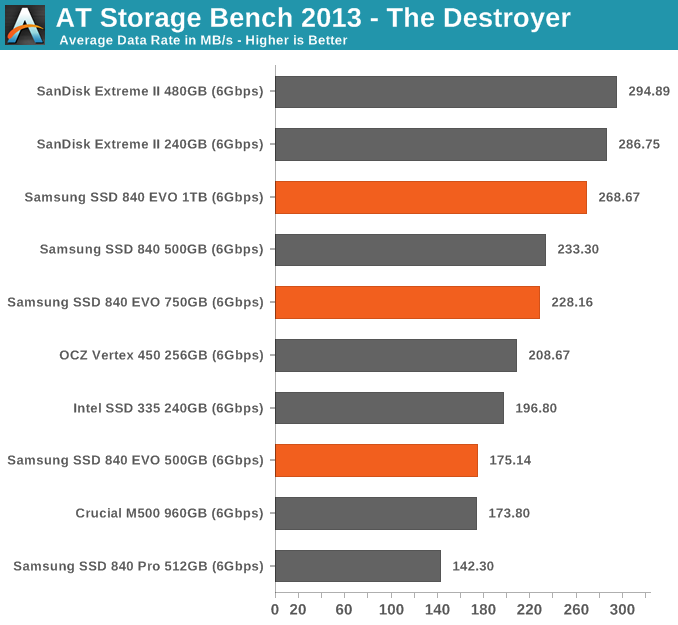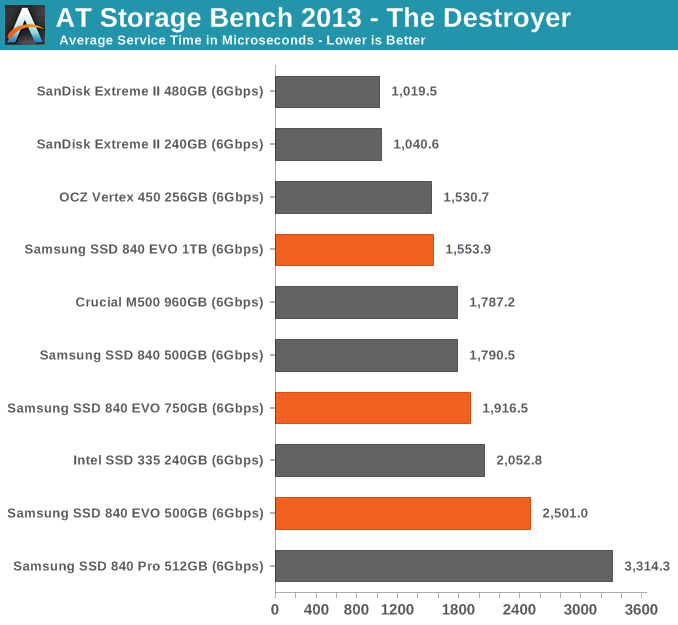Samsung SSD 840 EVO Review: 120GB, 250GB, 500GB, 750GB & 1TB Models Tested
by Anand Lal Shimpi on July 25, 2013 1:53 PM EST- Posted in
- Storage
- SSDs
- Samsung
- TLC
- Samsung SSD 840
AnandTech Storage Bench 2013
When I built the AnandTech Heavy and Light Storage Bench suites in 2011 I did so because we didn't have any good tools at the time that would begin to stress a drive's garbage collection routines. Once all blocks have a sufficient number of used pages, all further writes will inevitably trigger some sort of garbage collection/block recycling algorithm. Our Heavy 2011 test in particular was designed to do just this. By hitting the test SSD with a large enough and write intensive enough workload, we could ensure that some amount of GC would happen.
There were a couple of issues with our 2011 tests that I've been wanting to rectify however. First off, all of our 2011 tests were built using Windows 7 x64 pre-SP1, which meant there were potentially some 4K alignment issues that wouldn't exist had we built the trace on a system with SP1. This didn't really impact most SSDs but it proved to be a problem with some hard drives. Secondly, and more recently, I've shifted focus from simply triggering GC routines to really looking at worst case scenario performance after prolonged random IO. For years I'd felt the negative impacts of inconsistent IO performance with all SSDs, but until the S3700 showed up I didn't think to actually measure and visualize IO consistency. The problem with our IO consistency tests are they are very focused on 4KB random writes at high queue depths and full LBA spans, not exactly a real world client usage model. The aspects of SSD architecture that those tests stress however are very important, and none of our existing tests were doing a good job of quantifying that.
I needed an updated heavy test, one that dealt with an even larger set of data and one that somehow incorporated IO consistency into its metrics. I think I have that test. I've just been calling it The Destroyer (although AnandTech Storage Bench 2013 is likely a better fit for PR reasons).
Everything about this new test is bigger and better. The test platform moves to Windows 8 Pro x64. The workload is far more realistic. Just as before, this is an application trace based test - I record all IO requests made to a test system, then play them back on the drive I'm measuring and run statistical analysis on the drive's responses.
Imitating most modern benchmarks I crafted the Destroyer out of a series of scenarios. For this benchmark I focused heavily on Photo editing, Gaming, Virtualization, General Productivity, Video Playback and Application Development. Rough descriptions of the various scenarios are in the table below:
| AnandTech Storage Bench 2013 Preview - The Destroyer | ||||||||||||
| Workload | Description | Applications Used | ||||||||||
| Photo Sync/Editing | Import images, edit, export | Adobe Photoshop CS6, Adobe Lightroom 4, Dropbox | ||||||||||
| Gaming | Download/install games, play games | Steam, Deus Ex, Skyrim, Starcraft 2, BioShock Infinite | ||||||||||
| Virtualization | Run/manage VM, use general apps inside VM | VirtualBox | ||||||||||
| General Productivity | Browse the web, manage local email, copy files, encrypt/decrypt files, backup system, download content, virus/malware scan | Chrome, IE10, Outlook, Windows 8, AxCrypt, uTorrent, AdAware | ||||||||||
| Video Playback | Copy and watch movies | Windows 8 | ||||||||||
| Application Development | Compile projects, check out code, download code samples | Visual Studio 2012 | ||||||||||
While some tasks remained independent, many were stitched together (e.g. system backups would take place while other scenarios were taking place). The overall stats give some justification to what I've been calling this test internally:
| AnandTech Storage Bench 2013 Preview - The Destroyer, Specs | |||||||||||||
| The Destroyer (2013) | Heavy 2011 | ||||||||||||
| Reads | 38.83 million | 2.17 million | |||||||||||
| Writes | 10.98 million | 1.78 million | |||||||||||
| Total IO Operations | 49.8 million | 3.99 million | |||||||||||
| Total GB Read | 1583.02 GB | 48.63 GB | |||||||||||
| Total GB Written | 875.62 GB | 106.32 GB | |||||||||||
| Average Queue Depth | ~5.5 | ~4.6 | |||||||||||
| Focus | Worst case multitasking, IO consistency | Peak IO, basic GC routines | |||||||||||
SSDs have grown in their performance abilities over the years, so I wanted a new test that could really push high queue depths at times. The average queue depth is still realistic for a client workload, but the Destroyer has some very demanding peaks. When I first introduced the Heavy 2011 test, some drives would take multiple hours to complete it - today most high performance SSDs can finish the test in under 90 minutes. The Destroyer? So far the fastest I've seen it go is 10 hours. Most high performance I've tested seem to need around 12 - 13 hours per run, with mainstream drives taking closer to 24 hours. The read/write balance is also a lot more realistic than in the Heavy 2011 test. Back in 2011 I just needed something that had a ton of writes so I could start separating the good from the bad. Now that the drives have matured, I felt a test that was a bit more balanced would be a better idea.
Despite the balance recalibration, there's just a ton of data moving around in this test. Ultimately the sheer volume of data here and the fact that there's a good amount of random IO courtesy of all of the multitasking (e.g. background VM work, background photo exports/syncs, etc...) makes the Destroyer do a far better job of giving credit for performance consistency than the old Heavy 2011 test. Both tests are valid, they just stress/showcase different things. As the days of begging for better random IO performance and basic GC intelligence are over, I wanted a test that would give me a bit more of what I'm interested in these days. As I mentioned in the S3700 review - having good worst case IO performance and consistency matters just as much to client users as it does to enterprise users.
I'm reporting two primary metrics with the Destroyer: average data rate in MB/s and average service time in microseconds. The former gives you an idea of the throughput of the drive during the time that it was running the Destroyer workload. This can be a very good indication of overall performance. What average data rate doesn't do a good job of is taking into account response time of very bursty (read: high queue depth) IO. By reporting average service time we heavily weigh latency for queued IOs. You'll note that this is a metric I've been reporting in our enterprise benchmarks for a while now. With the client tests maturing, the time was right for a little convergence.

There's simply no comparison between the EVO and Crucial's M500. Even at half the capacity, the EVO does a better job in our consistency test. SanDisk's Extreme II remains the king here but that's more of a performance tuned part vs. something that offers better cost per GB. Note just how impactful the added spare is on giving the EVO an advantage over even the 840 Pro. It's so very important that 840 Pro owners keep as much free space on the drive as possible to keep performance high and consistent.











137 Comments
View All Comments
Sivar - Thursday, July 25, 2013 - link
Really well-written article.I have to admit, while most of Samsung's products are crap, their 840 and later SSDs are not bad at all.
(The 830, while not prone to electronic failure, was built really poorly. It's SATA connector would snap off if you tilted your head the wrong way while looking at it).
Coup27 - Thursday, July 25, 2013 - link
Samsung have gotten into the world position they are in today by selling crap. I have used plenty of 830's and I have never had an issue with the SATA connector so I have no idea what you are doing with it.Coup27 - Thursday, July 25, 2013 - link
Haven't ^^ (why is there no edit button?)piroroadkill - Thursday, July 25, 2013 - link
So you accidentally broke a SATA connector, and now that's suddenly a flaw? I have two Samsung 830 256GB in my system, and somehow I didn't break the SATA connectors...I also fitted 4x Samsung 830 256GB to a server at work.. and somehow I didn't break the SATA connectors..
HisDivineOrder - Saturday, July 27, 2013 - link
True, this. SATA connectors are poorly designed, but that's the fault of the people who made the spec, not the specific one in the 830. I'm not saying it can't break. I've had SATA connectors break on a variety of devices. None of them were my 830, but I'm not saying it's impossible or whatever.I've seen WD, Seagate, and Hitachi drives all have a problem with the connector, though. Seems like SATA and HDMI were designed to make the connection as loose and easily broken as possible. I guess that gives them some small percentage of people buying all new product to replace something on said product that's small and plastic...
mmaenpaa - Thursday, July 25, 2013 - link
Good article once again Anand,and very good perfomance for this price range.
Regarding Torx, I believe this is one the main reasons why it is used:
"By design, Torx head screws resist cam-out better than Phillips head or slot head screws. Where Phillips heads were designed to cause the driver to cam out, to prevent overtightening, Torx heads were designed to prevent cam-out. The reason for this was the development of better torque-limiting automatic screwdrivers for use in factories. Rather than rely on the tool slipping out of the screw head when a torque level is reached, thereby risking damage to the driver tip, screw head and/or workpiece, the newer driver design achieves a desired torque consistently. The manufacturer claims this can increase tool bit life by ten times or more"
(from https://en.wikipedia.org/wiki/Torx)
BR,
Markku
hybrid2d4x4 - Thursday, July 25, 2013 - link
For what it's worth, my experience with screws is consistent with your post. I've never had a torx screw slip out, which is definitely not the case with philips or the square or flathead varieties. I'd like to see them used more often.piroroadkill - Thursday, July 25, 2013 - link
Agreed. I love Torx. Philips and pozidriv are the terrible bastard children of the screw universe. Always slipping and burring. Ugh. If everything was replaced with totally cam-out free designs like Torx, allen head, robertson screw.. etc, etc.. then I'd be more than happy.psuedonymous - Thursday, July 25, 2013 - link
I'd LOVE for Torx to be used more often. They're much easier to work with (not once have I had a Torx screw fall off the screwdriver and roll under the desk), the screwheads are more robust, and they frankly look a lot nicer than Philips or Pozidriv.It'd make pulling apart laptops all day a darn sight less onerous if Torx were the standard rather than Philips.
camramaan - Friday, February 14, 2014 - link
But then there would be less security in other areas of the mechanical world... not everyone can carry a bunch of Torx bits everywhere they go, so breaking into, or disassembling something built with Torx is more time laborious and pre-planned. I fully understand the sentiments, but the development of alternative screw heads was more for security than ease of use.